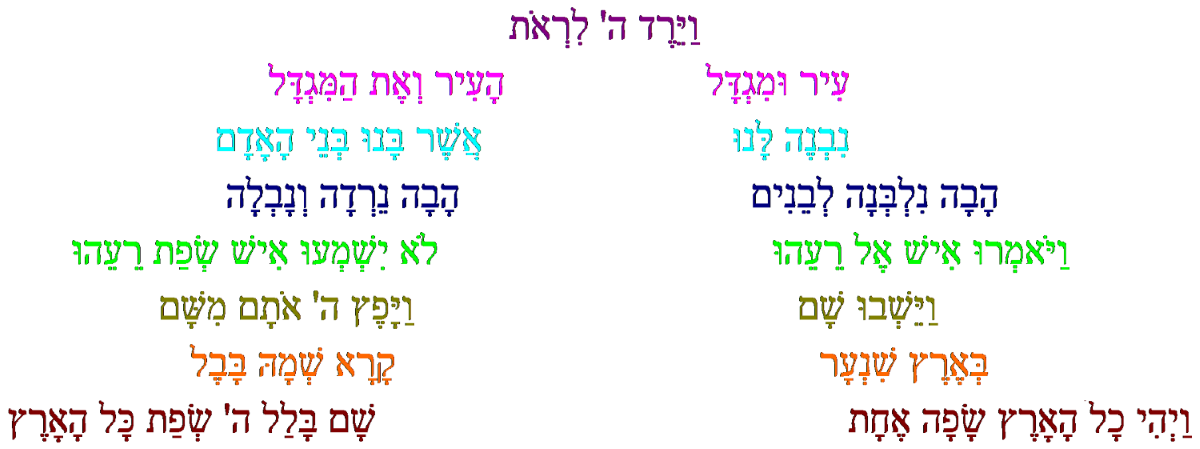Literary Devices – Bereshit 11
Parallels
There are several parallels between the first and second half of the unit:
.
| וַיְהִי כׇל הָאָרֶץ שָׂפָה אֶחָת | הֵן עַם אֶחָד וְשָׂפָה אַחַת לְכֻלָּם |
| הָבָה נִלְבְּנָה לְבֵנִים | הָבָה נֵרְדָה וְנָבְלָה |
| פֶּן נָפוּץ עַל פְּנֵי כׇל הָאָרֶץ | וַיָּפֶץ י״י אֹתָם מִשָּׁם עַל פְּנֵי כׇל הָאָרֶץ |
| אֶת הָעִיר וְאֶת הַמִּגְדָּל אֲשֶׁר בָּנוּ | וַיַּחְדְּלוּ לִבְנֹת הָעִיר |
Chiastic Structure
The chiastic structure below highlights Hashem's step by step undoing of the human plan.1

Alliteration and Plays on Words
The text plays with language, being filled with both alliteration and word plays,2 thereby mirroring one of the the key themes of the unit, the creation of languages:
(א) וַיְהִי כׇל הָאָרֶץ שָׂפָה אֶחָת וּדְבָרִים אֲחָדִים. (ב) וַיְהִי בְּנׇסְעָם מִקֶּדֶם וַיִּמְצְאוּ בִקְעָה בְּאֶרֶץ שִׁנְעָר וַיֵּשְׁבוּ שָׁם. (ג) וַיֹּאמְרוּ אִישׁ אֶל רֵעֵהוּ הָבָה נִלְבְּנָה לְבֵנִים וְנִשְׂרְפָה לִשְׂרֵפָה וַתְּהִי לָהֶם הַלְּבֵנָה לְאָבֶן וְהַחֵמָר הָיָה לָהֶם לַחֹמֶר. (ד) וַיֹּאמְרוּ הָבָה נִבְנֶה לָּנוּ עִיר וּמִגְדָּל וְרֹאשׁוֹ בַשָּׁמַיִם וְנַעֲשֶׂה לָּנוּ שֵׁם פֶּן נָפוּץ עַל פְּנֵי כׇל הָאָרֶץ. (ה) וַיֵּרֶד י"י לִרְאֹת אֶת הָעִיר וְאֶת הַמִּגְדָּל אֲשֶׁר בָּנוּ בְּנֵי הָאָדָם. (ו) וַיֹּאמֶר י"י הֵן עַם אֶחָד וְשָׂפָה אַחַת לְכֻלָּם וְזֶה הַחִלָּם לַעֲשׂוֹת וְעַתָּה לֹא יִבָּצֵר מֵהֶם כֹּל אֲשֶׁר יָזְמוּ לַעֲשׂוֹת. (ז) הָבָה נֵרְדָה וְנָבְלָה שָׁם שְׂפָתָם אֲשֶׁר לֹא יִשְׁמְעוּ אִישׁ שְׂפַת רֵעֵהוּ. (ח) וַיָּפֶץ י"י אֹתָם מִשָּׁם עַל פְּנֵי כׇל הָאָרֶץ וַיַּחְדְּלוּ לִבְנֹת הָעִיר. (ט) עַל כֵּן קָרָא שְׁמָהּ בָּבֶל כִּי שָׁם בָּלַל י"י שְׂפַת כׇּל הָאָרֶץ וּמִשָּׁם הֱפִיצָם י"י עַל פְּנֵי כׇּל הָאָרֶץ
(1) And the whole earth was of one language and of one speech. (2) And it came to pass, as they journeyed east, that they found a plain in the land of Shinar; and they dwelt there. (3) And they said one to another: 'Come, let us make brick, and burn them thoroughly.' And they had brick for stone, and slime had they for mortar. (4) And they said: 'Come, let us build us a city, and a tower, with its top in heaven, and let us make us a name; lest we be scattered abroad upon the face of the whole earth.' (5) And the Lord came down to see the city and the tower, which the children of men built. (6) And the Lord said: 'Behold, they are one people, and they have all one language; and this is what they begin to do; and now nothing will be withholden from them, which they purpose to do. (7) Come, let us go down, and there confound their language, that they may not understand one another's speech.' (8) So the Lord scattered them abroad from thence upon the face of all the earth; and they left off to build the city. (9) Therefore was the name of it called Babel; because the Lord did there confound the language of all the earth; and from thence did the Lord scatter them abroad upon the face of all the earth.
These plays on words and sounds are pointed out by Robert Alter in his commentary on Bereshit.3 In verse 3 the whimsical, rhyming sounds of the text perhaps serve to make light of the builders’ plans, which they viewed as grand but were ultimately foolish and doomed. Similarly, the play on "בבל" and "בלל" might be a mocking of pagan hubris. Bavel, the Torah says, does not mean "Bab-ilu" (literally, "gateway of god" in Akkadian), but rather confusion and chaos. See discussion in Deconstructing Migdal Bavel.
Keywords4
- יהב – Tanakh Lab demonstrates that the root “יהב” (meaning in context approximately “come, let us”) is the most significantly repeated word in this story relative to the rest of Tanakh.5 This root is used to ironic effect: the people use it to initiate the processes of baking bricks and building the tower, to which God echoes: “Come, let us go down and mix up their languages.”
- פוץ – Tanakh Lab demonstrates that the verb root “פוץ” is the second most significantly repeating word in the story of the Tower of Bavel, relative to the rest of Sefer Bereshit and the rest of Tanakh.6 Here too, the root is used ironically: the people express their desire to build a tower “lest we disperse,” and God responds by dispersing them.
- ארץ – See the Tanakh Lab that the word "אָרֶץ" appears six times in the unit, the phrase "כׇל הָאָרֶץ" five times, and the fuller phrase "עַל פְּנֵי כׇל הָאָרֶץ" three times.
- שפה – This word, too, appears five times in the unit.